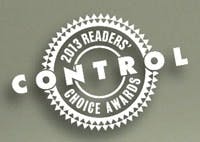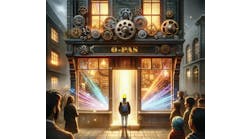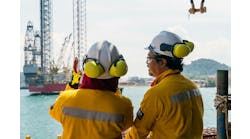Who Had the Nicest Ice in This Year's Readers' Choice Awards?
By the Editors of Control
This is the 21st Readers Choice Awards. In the 21 years we have been conducting this survey, technology has changed, the process industry has changed, our ways of working and our demographics have changed. Most of the ways we do our jobs are considerably different now than in 1991.
Twenty-one years ago, there were no smartphones, no tablet computers, no widely used Internet, no Wi-Fi or many other tools we take for granted as we do our jobs, such as OPC and virtualization. Twenty-one years ago, Microsoft Windows was still in its infancy, and many control systems were designed to run on Unix, or other, proprietary operating systems. Commercial off-the-shelf (COTS) components and products were nearly unheard of, while today they are the norm. Systems were isolated, and networks were rare. Manufacturing and maintenance data were transcribed manually, and recordkeeping was done on paper. Now only industry laggards work that way.
Twenty-one years ago, we were not working in a completely globalized process industry. Twenty-one years ago, a majority of process automation workers were not soon headed to retirement, with the average age falling into the 50s. Twenty-one years ago, it was unheard of to work remotely via computer. Now all of those things are true and commonplace.
Every year, we offer an incentive drawing for our respondents to encourage more of them to fill out the very long and sometimes quite difficult response form. This year, we offered Kindle Fire tablets to winners drawn randomly from among all survey participants. The winners of the tablets are:
• Ralph Lien of The Dow Chemical Company
• Craig Alexander of Monsanto
• Carl Withers of Kraft Foods
• Qi Yan of Bechtel
We want to thank every single one of our respondents for participating in the survey, and we want to congratulate our four Kindle Fire winners! Thanks for helping us make the Readers' Choice Awards the touchstone for brand recognition and brand value surveys in the process industries.
Some of the winners of the Readers' Choice Awards have also changed. Sometimes the names have changed, as acquisitions have taken their toll, but also companies have dropped off or been added to the list of award winners. In the past few years, as the pace of acquisition slowed, the names on the list began to be like the "usual suspects" in the police captain's raid order in the movie "Casablanca."
We have made changes in the survey, too. We've added categories, removed a few and changed how we present the data. We've also changed how we actually do the survey. When we started this survey, we did it by mail. Today, we do it by email, surveying our readers and asking them to state their brand preferences in over 100 categories of process automation equipment and software. We are proud of the progress of this survey, and we know how important it is.
Trust us, we get the phone calls from unhappy vendors.
We have surveyed our readers, and this year's results reflect the collective wisdom of hundreds of process automation professionals. The survey does have a North American bias, but as we have noted for several years now, the number of responses from outside North America continues to grow, and the survey results reflect some of those demographic changes, just as our industry itself does. We poll from the print magazine's readers, subscribers to our digital media and social media outlets, and we select for end users and integrators and engineers.
Why Is This Survey Important?The survey we do annually and the Readers' Choice Awards that result from it are the only completely unaided brand preference survey in the process industries. As we have done for many years now, we pulled a random sample of end users from our databases, and we asked them to answer a series of unaided (that means they have to write in the answer, without "help" from a pre-selected series of names in a drop down box) to each of the questions in the survey.
This means that Control's staff has to make sure that we correctly count all the choices. This is a significant chore, because, thanks to acquisitions and name changes, it is harder than you'd think to figure out which company the end user really means. For example, there are over 21 ways to name an ABB product, without the use of the name ABB. Similar issues arise for nearly all the Top 50 (see our December cover story), or so it seems every year.
As we pointed out last year, this is an extremely important datum. Sure, it signals that the Control staff has the experience in the industry to be able to make those choices, but much more important, it says clearly that the persistence of original brands, such as Rosemount or Allen-Bradley, is maintained in the minds of end users even after two decades of name changes, acquisitions and the passage of time.
This is a private survey. That is, we select the participants, and we take great care to control the respondents to make the survey as accurate and unbiased as is possible.
What the Survey Shows
For the fifth year now we have broken out the control system awards two ways: by industry vertical and by discipline. Above, we've shown the best overall winners in each industry vertical for the six basic process control disciplines: Batch Process Control, Continuous Regulatory Control, Continuous Sheet/Web Monitoring and Control, Safety/Emergency Shut-Down, Sequential Logic Control and Supervisory Control and Data Acquisition (see Table 1: "Best in Control" Readers' Choice Awards by Process Automation Discipline"). Also we have shown all the winners in each category by industry vertical (see Table 2: "Best in Control" Readers' Choice Awards by Process Automation Discipline and Industry").
As we have seen for the past several years, the same names of vendors appear in each category. The most that happens is that one or another vendor will trade places and move up or down in the list in each category. As we say every year, the statistical differences between places in the category winners list are small enough that they are not truly able to signify a real change in brand strength or end user preference. Every vendor that is listed in a category is a winner, whether they are in first or last place in the tables.
We do our best to maintain a very wide demographic split among respondents. Control takes a horizontal slice out of the process industry verticals. Our demographics represent that slice:
• Chemicals manufacturing 20%
• Electric power generation 10%
• Food and beverage manufacturing 15%
• Metals, minerals and mining 8%
• Oil and gas production 13%
• Petroleum refining 7%
• Pharmaceuticals/life sciences 6%
• Plastics and rubber manufacturing 5%
• Pulp and paper manufacturing 9%
Control's editorial position has been, since our founding, that the systems, equipment and services the vendors supply to the process industries, as well as the ways those products are used in each industry vertical, provide enough crossover for the experiences and case studies we find in one vertical to be interesting, useful and informative to readers in another vertical. So too, we believe that a vote from a respondent in one vertical must be weighted the same as a vote from a respondent in any other vertical. This makes the Readers' Choice Award survey highly representative across all the industry verticals of the process industry.
Why Do the Same Vendors Win Every Year?
Every one of the companies listed in any of the categories has managed to produce for itself one or more powerful brands. Brands are not bought, although good advertising and marketing highlight the brand values of products. Brands are made by hard work on the part of vendors' designers, manufacturing, quality control, service, field technical support and the way that each product fits the requirements of the customers who must use the products to make their own products.
Vendors who remember that the end users aren't technology wonks, interested in the products for the products' sake, have better branding than vendors who get all involved in features and functions of their products. Vendors who understand that the end users want their products to work as transparently as possible and make the end users' working lives easier have the strongest brand values. It might be heresy to say this, but what matters is how well a vendor takes care of the customer, not necessarily how good its products are. Good products are merely the ticket of entry in the process automation industry. Customers expect the vendors' products to be good.
As we said last year, vendors ask regularly how to "win" the Readers' Choice Awards. The answer, as we have said before, is to spend lots of time and money providing outstanding service to your user base and communicating what you've done to the largest market grouping you can.
The vendors who appear in this survey every year have mastered the art of making good products and supporting them with very high quality field technical support. In so doing, they have maximized the values of their products' brands. Branding is about "walking the walk" and "talking the talk," and these vendors do just that.
Software Makes the Vendor
Every year, some of the same names make this list because they have demonstrated again and again that their software works and is supported reliably. These vendors have not only the product design expertise, but also the application expertise to assist their customers to use their software for what the customer really wants to do: make oil products or chemicals or food or ore or paper or — well, you get the point. One of the things this part of the survey points out every year is that branding isn't just for big vendors. This year, we see smaller vendors such as TiPS, Expertune, Control Station, ControlSoft and others in various categories, and a small company, Mynah Technologies, even winning the simulation software category (Table 3).
Seeing Is Believing
Ever since the days of the panel wall, end users have needed ways to see what was going on in the plant. We still see many of the same types of devices we saw 21 years ago in this category. Most have been updated, but some still look like they did in the 1990s and are still going strong. Some are changed beyond all recognition. Industrial computers are now common, where they were rare when this survey got started. Operator interface terminals are themselves embedded industrial computers. Recorders, once based on ink on paper are now most commonly video displays mated with dataloggers. Still, the companies you see here are some of the same companies you saw in the first Readers' Choice Award survey (Table 4).
It's All About Infrastructure
These days, it's all about data. But you can't use data you can't get. So manufacturers of infrastructure products such as I/O and terminal strips, wire and cable, and power supplies and signal conditioners should not be forgotten. A category that absolutely was not even thought of for the first Readers' Choice Awards is "wireless infrastructure," which got a mixture of votes for 802.11 infrastructure (Cisco) and wireless sensor networks (Emerson, et al.) (Table 5).
The Big Four: Flow, Level, Pressure and Temperature
For more than 100 years, the process industries have controlled by means of four basic variables: flow, level, pressure and temperature. Process automation professionals have strongly held favorites in each of these categories, but newer technologies are also used. There is no such thing as the "perfect instrument" here. That's why there are so many sub-categories in each grouping.
The Masters of Flow
You'd think there wasn't anything else to add about flow, but you'd be wrong. Every one of the major flow vendors released new devices in the past year, but each of the winners in this category proves that you need to provide the best product you can and support it the best way you know how. There have been some name changes, like Vega Americas, formerly Ohmart Vega. Some of the names are different, but many of the products are the same as in the first survey, 21 years ago (Table 6).
Getting on the Level
Level is a very tricky measurement, so the number of ways to make the measurement are many and technically quite difficult. There are some changes here. The biggest one is that we lumped all forms of radar level together, since the customers didn't seem to differentiate between non-contact and contacting radar level instruments. And ABB won the laser category, through its subsidiary formerly known as K-Tek. In the nuclear level gauge category VEGA Americas won again. The interesting story here is that just shortly after introducing its product into the United States, Endress+Hauser has already placed third (Table 7).
Pressure and Temperature, Oh My
As usual, Emerson Process Management and Fluke won these categories, but surprisingly, there were new vendors in the Infrared Temperature Sensor category: LumaSense and Williamson. Once again, we see that if there is a new product that serves the end user base, they'll use it and recommend it (Table 8).
Looky Here, Watch This Analyzer
More and more, analyzers are going on-line or at-line, because of the increasing emphasis on process quality. These vendors clearly know how to make a complicated product dependable and durable enough to use as a process sensor. Once again, ABB, Emerson Process Management and Yokogawa repeat as the leaders in most of these categories (Table 9).
The Essential Final Control Elements
All the sensors and software in the world won't help you if you don't have dependable and accurate final control elements. As usual, Emerson Process Management, the world's largest control valve vendor, won the category for "Control Valve," but there are other vendors grabbing end users' attention too. In the "Electric Motor Drive" category, Rockwell and Toshiba crashed the party at numbers 1 and 5 respectively. In the "Electric Motor" category, the Baldor Electric win again shows the slight bias toward North America in the survey, with Siemens Industry second. The bias is getting less, as is shown by the addition of SEW Eurodrive to the category (Table 10).
Last, But Not Least: The Indispensables
You can't have data without data acquisition systems, and you can't put sensors in the field without enclosures to put them in. Pentair wins again, for its Hoffman brand, with Rittal and Hammond Manufacturing in the second and third positions.
Sometimes you just can't improve on a technology. Pepperl+Fuchs wins again for purge systems.
The list of portable calibrator vendors is getting longer, and the calibrators are getting more sophisticated, with multifunction documenting calibrators all the rage. Fluke, a relative newcomer to calibrators, wins this year.
What a "remote terminal unit" is these day is subject to debate, but our readers know whose they like. Rockwell Automation, Emerson Process Management, Schneider Electric, ABB and Yokogawa all get the nod in the RTU category (Table 11).
We see an additional vendor in the "Instrument Fittings" category, Anderson Greenwood, and some new faces in the "Vibration Instrumentation" category: Fluke, ifm efector and IRD Mechanalysis. And last, but certainly not least, in the "Weighing System/Load Cell" category, Mettler Toledo takes top honors, followed by the usual suspects and a new name in the category, but an old name in weighing: Fairbanks Scales.

Leaders relevant to this article:





